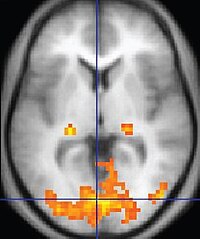
Photo from wikipedia
BACKGROUND Independent testing of image quality metrics is important to provide an unbiased determination of medical imaging performance. Due to the underreporting by vendors of dead detector elements, which are… Click to show full abstract
BACKGROUND Independent testing of image quality metrics is important to provide an unbiased determination of medical imaging performance. Due to the underreporting by vendors of dead detector elements, which are elements that do not function but may be corrected using information from surrounding pixels, the health of all imaging detector elements is infrequently reported and extraordinarily difficult to independently determine or verify through traditional means without vendor largesse. In many instances, dead detector data, or dead pixel maps, are only available at the discretion of the vendors, which renders this data inaccessible to many medical physicists. PURPOSE We provide a mechanism to predict which detector elements are dead from a single flat field image and describe a convolutional neural network to address this task. This technique provides a vendor-independent, and potential correction algorithm-independent means for obtaining this information, which directly relates to the image quality of the diagnostic imaging system. METHODS A data set of 61 flat field images was obtained from two Varian on-board imaging (OBI) systems. These images were taken with a range of kVp and mAs settings and with differing levels of copper filtration in the beam path. The dead pixel maps for these detectors were also acquired and used to label the ground truth sub-images-or small square images from the original, larger image- from the flat field images. This data set was then used to train, test, and validate five unique convolutional neural networks on the task of identifying dead detector elements from sub-images derived from the flat field images. RESULTS The convolutional neural networks were validated with an average precision of 0.96, an average recall of 0.48, and an average F1 score of 0.55 attributed to the scarcity and imbalanced nature of available data, and the difficulty in training neural networks using flat-field images. However, performance drastically improved when utilizing a subset of the data with a high dynamic range. CONCLUSION This work shows the feasibility of using a convolutional neural network to detect dead detector elements from flat field images taken on a detector. Robust training of this type of algorithm could lead to a generalized model that may provide an independent evaluation of dead detectors for a wide range of vendors and models. Ultimately, this method can be a valuable tool for physicists performing quality assurance procedures on all digital diagnostic imaging systems, including X-ray, mammography, and fluoroscopy. This article is protected by copyright. All rights reserved.
Journal Title: Medical physics
Year Published: 2022
Link to full text (if available)
Share on Social Media: Sign Up to like & get
recommendations!